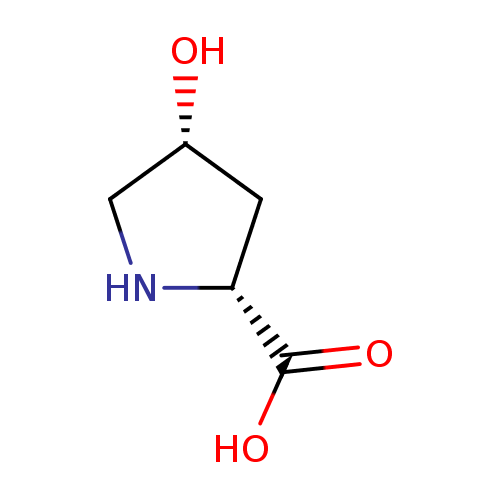|
Record Information |
|---|
| Version |
1.0 |
|---|
| Update Date |
1/22/2018 11:54:54 AM |
|---|
|
Metabolite ID | PAMDB110636 |
|---|
|
Identification |
|---|
| Name: |
cis-4-hydroxy-D-proline |
|---|
| Description: | Zwitterionic form of cis-4-hydroxy-D-proline having an anionic carboxy group and a protonated amino group. |
|---|
|
Structure |
|
|---|
| Synonyms: | |
|---|
|
Chemical Formula: |
C5H9NO3
|
|---|
| Average Molecular Weight: |
132.0660681925 |
|---|
| Monoisotopic Molecular
Weight: |
132.0660681925 |
|---|
| InChI Key: |
PMMYEEVYMWASQN-QWWZWVQMSA-N |
|---|
| InChI: |
InChI=1S/C5H9NO3/c7-3-1-4(5(8)9)6-2-3/h3-4,6-7H,1-2H2,(H,8,9)/t3-,4-/m1/s1 |
|---|
| CAS
number: |
Not Available |
|---|
| IUPAC Name: | (2R,4R)-4-hydroxypyrrolidinium-2-carboxylate |
|---|
|
Traditional IUPAC Name: |
cis-4-hydroxy-D-proline |
|---|
| SMILES: | C1([N+]C(C([O-])=O)CC(O)1) |
|---|
|
Chemical Taxonomy |
|---|
|
Taxonomy Description | This compound belongs to the class of chemical entities known as proline and derivatives. These are compounds containing proline or a derivative thereof resulting from reaction of proline at the amino group or the carboxy group, or from the replacement of any hydrogen of glycine by a heteroatom. |
|---|
|
Kingdom |
Chemical entities |
|---|
| Super Class | Organic compounds |
|---|
|
Class |
Organic acids and derivatives |
|---|
| Sub Class | Carboxylic acids and derivatives |
|---|
|
Direct Parent |
Proline and derivatives |
|---|
| Alternative Parents |
|
|---|
| Substituents |
- Proline or derivatives
- Alpha-amino acid
- D-alpha-amino acid
- Pyrrolidine carboxylic acid
- Pyrrolidine carboxylic acid or derivatives
- Pyrrolidine
- 1,2-aminoalcohol
- Amino acid
- Secondary alcohol
- Carboxylic acid
- Secondary aliphatic amine
- Monocarboxylic acid or derivatives
- Azacycle
- Secondary amine
- Organoheterocyclic compound
- Organooxygen compound
- Organonitrogen compound
- Alcohol
- Organic nitrogen compound
- Organopnictogen compound
- Organic oxide
- Hydrocarbon derivative
- Organic oxygen compound
- Amine
- Carbonyl group
- Aliphatic heteromonocyclic compound
|
|---|
| Molecular Framework |
Aliphatic heteromonocyclic compounds |
|---|
| External Descriptors |
|
|---|
|
Physical Properties |
|---|
| State: |
Not Available |
|---|
| Charge: | 0 |
|---|
|
Melting point: |
Not Available |
|---|
| Experimental Properties: |
| Property | Value | Reference |
|---|
| Melting Point | Not Available | Not Available | | Boiling Point | Not Available | Not Available | | Water Solubility | Not Available | Not Available | | LogP | Not Available | Not Available |
|
|---|
| Predicted Properties |
|
|---|
|
Biological Properties |
|---|
| Cellular Locations: |
Not Available |
|---|
| Reactions: | |
|---|
|
Pathways: |
- trans-4-hydroxy-L-proline degradation IIPWY-5159
|
|---|
|
Spectra |
|---|
| Spectra: |
Not Available |
|---|
|
References |
|---|
| References: |
- Magrane M, Consortium U: UniProt Knowledgebase: a hub of integrated protein data. Database (Oxford). 2011 Mar 29;2011:bar009. doi: 10.1093/database/bar009. Print 2011. [21447597 ]
|
|---|
| Synthesis Reference: |
Not Available |
|---|
| Material Safety Data Sheet (MSDS) |
Not Available |
|---|
|
Links |
|---|
| External Links: |
|
|---|


